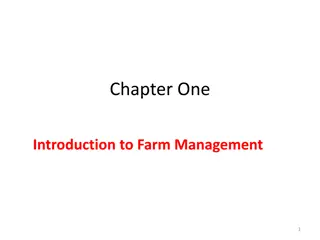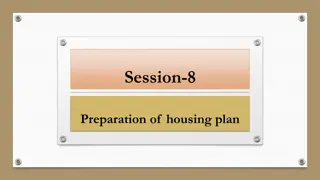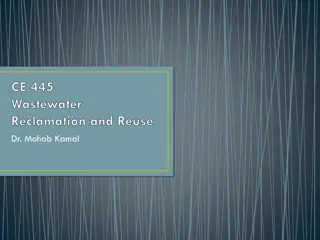Year 1 Financial Assessment and Risk Monitoring (FARM) Implementation Overview
Year 1 of the Financial Assessment and Risk Monitoring (FARM) implementation focused on operationalizing processes for screening, assessing, and monitoring private, independent institutions in Massachusetts. The journey included establishing protocols, trustee training, risk mitigation plans, and contingency closure planning to ensure compliance with regulations and prevent imminent closures.
Uploaded on Oct 05, 2024 | 0 Views
Download Presentation

Please find below an Image/Link to download the presentation.
The content on the website is provided AS IS for your information and personal use only. It may not be sold, licensed, or shared on other websites without obtaining consent from the author. Download presentation by click this link. If you encounter any issues during the download, it is possible that the publisher has removed the file from their server.
E N D
Presentation Transcript
Financial Assessment and Risk Monitoring (FARM) of Independent Institutions: Year 1 Review Board of Higher Education Meeting, June 22, 2021
Private, Independent IHEs Overview: MA FARM Law All MA-based, private IHEs located in MA and authorized to grant degrees must be annually screened and assessed to determine whether they are at risk of imminent closure. BHE must establish process to conduct these annual financial screenings and assessments for at risk of imminent closure determinations Financial screenings may be conducted by accrediting agency (NECHE), pursuant to an MOU IHEs must: proactively notify BHE of any known financial liabilities or risks . annually post audited financial statements ensure their trustees receive instruction and training, at least once every four years, on fiduciary duty and financial metrics 2
Financial Assistance and Risk Monitoring (FARM) Implementation Timeline Overview June 2018-January 2019: THESIS recommendations; BHE accepts report (BHE 19-04) June 18, 2019: BHE Vote to put draft regulations out for formal public comment (BHE 19-06) November 14, 2019: Legislation enacted and signed November- December 2019: DHE staff revise regulations January 10, 2020: BHE Vote on final regulations (BHE 20-03); ongoing NECHE MOU negotiations April 8, 2020: BHE Vote related to implementation (NECHE MOU and Implementation Procedures); immediate implementation April 2020- June 2021: Year 1 Implementation (see next slides): Operationalizing policies and procedures, screenings and assessments, review of risk mitigation plans, contingency closure planning, trustee training, etc. June 22, 2021 BHE Meeting-Year 1 Review or After Action Report 3
Agenda Year 1 Implementation Operationalized Business Processes- Dena Screening and Assessments- Tom Risk Mitigation Review and Monitoring- Tom Contingency Closure Planning- Pat Other requirements, IHE Reporting Portal Dena Recommendations, Next Steps 4
Year 1 FARM Implementation Operationalizing FARM: Internal Business Processes Process Managed by Cross-functional Regulatory Ream Legal- notice drafting; project management; external communications/tech assistance ANF- financial screenings and assessments; risk mitigation review/ monitoring Academic Affairs- contingency closure planning; risk mitigation review/ monitoring ALL- team members met weekly, participated in all phases of processes/ deliberations Established external & internal communication protocols; templates; data trackers; IHE reporting portal; website Adapted financial screening workbooks; created risk mitigation assessment summaries for Commissioner approval Established and Convened Commissioner s Advisory Committee Quarterly and as needed touchpoints 5
Year 1 Timeline Overview October 2020 DHE sent further action needed letters notifying institutions they may be at risk of imminent closure - Risk Mitigation Plans requested and Phase 1 Contingency Closure (610 CMR 13.03(2)) July September 2020 DHE discussed financial screening results with NECHE institutions April 26/27, 2020 DHE received FY19 screening results for NECHE institutions (610 CMR 13.03(1)(a)) June 12, 2020 DHE sent you have screened in letters to NECHE institutions (610 CMR 13.03(1)(c)) August 2020 DHE screened non-NECHE institutions (610 CMR 13.03(1)(a); 610 CMR 13.03(1)(c)) September 2020 Advisory Committee Touchpoint- screening results May 2020 Advisory Committee Touchpoint- Orientation 6
Year 1 Timeline Overview March June 2021 Ongoing review of institutional risk monitoring quarterly reports (610 CMR 13.03(3)) November 2020 DHE sent no further action needed letters to remaining screened-in institutions (610 CMR 13.03(2)) December 23, 2020 DHE sent moving to monitoring letters to screened-in institutions (610 CMR 13.03(2)(b)(1)) May 2021 NECHE transmission of FY20 screening results to DHE (610 CMR 13.03(1)(a)) November 2020 Advisory Committee Touchpoint Spring 2021 Advisory Committee Touchpoint 7
FARM Process- Summary Slide Screenings and Assessments, Phase 1- received screening results from NECHE (April 27); DHE conducted non-NECHE IHE screenings Phase 2- Protracted discussions with NECHE on screening results (April- June) Phase 3- DHE initiated screening result review with IHEs that screened-in (June) Phase 4- DHE either advanced IHES to Risk-Mitigation and Contingency Closure Planning, or notified IHEs that no further action is warranted (Early October) Review of Risk Mitigation Plans, Phase 5- DHE receives, reviews Risk Mitigation plans from identified IHEs (Late October) Phase 6- Determinations made on sufficiency of risk mitigation plans based on information received and the 18-month rule; all IHEs advanced to quarterly reporting and continued contingency closure planning (December 2020). Risk Mitigation Monitoring Phase 7- Quarterly report reviews, ongoing monitoring & contingency planning Contingency Closure Planning Initiated at Phase 4, continues as IHE advance through process 8
Financial Screenings All 85 Independent Institutions of Higher Education (IHEs) located in MA and authorized to grant degrees were screened 70 IHEs screened by NECHE, pursuant to MOU 15 IHEs screened by the DHE Same screening methodology used by NECHE and DHE, with four key financial health elements: Enrollment / Market Revenue 4 metrics Cash Flow Sufficiency 3 metrics Liquidity 2 metrics Wealth 3 metrics ARFE report required by NECHE when 4 or more metrics fall below set thresholds ( red flag ), with at least one red flag in the market or cash flow category. At least one red flag in enrollment/market revenue or cash flow sufficiency weights these factors more heavily than wealth or liquidity. 9
Financial Screenings- Observations NECHE invited Commissioner & Tom to March NECHE meeting and submitted summary results in April. Process delays between April-June seeking detail and underlying data from NECHE's financial screenings, then pivoting to recreating workbooks and accessing data from IHEs FY 22 Response- IHEs now sign a NECHE "Release Form" Few unique IHEs (e.g., out of state IHEs with MA satellite campus) do no fit well in screening methodology FY22 Response- Ongoing analysis; will build upon lessons learned in FY21 to assess the materiality of these distinctions and adapt. 12
Financial Assessments and Risk Monitoring- Observations Institutions were responsive, submitted timely risk mitigation plans, through narratives of plans. DHE completed risk assessments in November-December. FY22 Response- With the new, DHE-drafted "NECHE release forms;" business processes operationalized; and COVID impacts on enrollment more certain; DHE can complete risk assessments earlier (October). Risk mitigation plans varied in terms of substance and tone; no prescribed format. FY22 Response- IHE Presidents and Trustee chairs will sign Certification attesting IHE has both the means, and willingness (intention) to continue operations through end of next academic year. Inconsistent back-up documentation submitted with initial Risk Mitigation plans; follow up required by DHE. FY22 Response- With new NECHE Release DHE will have the ARFE reports sooner in the process and will be able to ask for specific documentation at earlier stage of Risk Mitigation plan process 13
Contingency Closure Planning Phase I (Fall) Contingency Phase 2 (Spring) Contingency Final Phase: Closure Contingency Closure Template Contingency Closure Template Notice of Closure Template Update Section B.3 with Spring Enrollment Numbers Section B.3: Attachment C (Program Inventory with CIP Codes) Complete all sections and attachments: Institutional Statement of Closure, Teach-Out Plan and Academic Integrity, Transfer Agreements, Student Data and Student Services, Administration, Communication and Records, Fiscal. Section C.4: Attachment E (Students receiving VA educational benefits) Section E: Communications and Records (Assessment) G2: Community Impact Table list of academic programs, CIP codes, 2-3 potential partners for each program, expected enrollments end of spring semester. Number of students by class year and accumulated credit bands as of the end of Spring semester (0-15, 16-30, etc.) Requires extensive back and forth with DHE staff until NOC is deemed sufficient. A list of collaborative agreements with other institutions and the corresponding controlling agreements (dual degrees, transfer programs, etc.)
Contingency Closure Planning- Observations In Year 1 initial Contingency Closure Planning began in October with light touch (Phase 1), with Increased requirements and requested revisions/ additions (Phase 2) followed DHE receipt and review of Risk Mitigation Plans. FY22 Response: For IHEs currently in Continued Risk Monitoring: Phase 1 and 2 completed. For IHEs newly screened-in: Phase 1 and Phase 2 Contingency Closure Planning are both required before Jan 1, simultaneously with Risk Mitigation Plan submissions. 15
Overview: MA Law on Annual Financial Assessments- DENA BHE must establish process to annually assess IHE financial information for at risk of imminent closure determination: Assessment must include annual screenings; Financial screenings may be conducted by accrediting agency (NECHE), pursuant to an MOU. IHEs must proactively notify BHE of any known financial liabilities or risks. IHEs must annually post audited financial statements. IHEs must ensure their trustees receive instruction and training, at least once every four years, on fiduciary duty and financial metrics 16 **Strict Confidentiality - DHE.FARMSubmissions@mass.gov
The Other Legal Requirements- IHEs must proactively notify BHE of any known financial liabilities or risks. All 85 IHEs received June 29, 2020 Notice from Commissioner with expectations on what/ how to report (confidentially): Anticipated problems relating to liquidity or cash deficiencies Any significant negative financial event Any decision to close any instructional locations New or continuing merger/ teach out discussions. Any major changes in academic programs Any other fiscal or adverse events reported to another oversight entity (e.g., accreditor) FY22 Recommendation- Consider requiring annual nothing to report IHE checkbox/confirmation. 17
The Other Legal Requirements IHEs must annually post audited financial statements. ALL 85 IHEs notified* of requirement and portal reporting process. 94% of IHEs in full compliance No FY22 recommendations at this time. IHEs must ensure their trustees receive instruction and training, at least once every four years, on fiduciary duty and financial metrics All 85 IHEs notified* of requirement and portal reporting process DHE worked with TBC/ AGO on comprehensive training offered live (Jan 26th) and now asynchronously (recorded) Nov 1, 2021- reporting deadline for trustees in key leadership roles No FY22 recommendations at this time. *DHE Legal Notices- June 29th, December 10th, January 11th (on trustee training). 18
FY22 Responses, Recommendations and Next Steps
Year 1 Issues Year 2 Approaches Issues Solutions Internal Management Need for accelerated deployment/implementation COVID-considerations Internal Management Operationalized business; developed template communications, financial screening workbooks, etc. NECHE Lost time in April-June on NECHE discussion for additional screening info. DHE recreated methodology through time-intensive, manual process. NECHE IHE Release Form developed and implemented for Year 2 to streamline NECHE data transfer Data from Salesforce will be in a better format for immediate DHE analysis Contingency closure planning Prior contingency closure plan template development process too binary. Phase 1 Contingency closure info limited to program inventory. Contingency closure planning Plan to accelerate contingency closure planning information sought before Jan 1 to include Phase 2 information. 20
Additional Recommendations Accelerate the timeline from December to October for at risk and public notice determinations By October fall enrollment should be known. Year 1 provides a baseline starting point for analysis Communications and workbook templates from Year 1 ready to go Require all private IHEs Presidents and Board Chairs that are assessed as at risk to submit Certifications Attesting that they have both the means (18 months) and intention (commitment) to stay open through end of next academic year. Increase DHE capacity and resources to conduct assessments, risk monitoring and contingency closure planning. FARM manager/ analyst position is funded and posted Explore procuring, as needed, DHE consultant support for on-site fiscal review, analysis and guidance in contingency closure phase to support an orderly closure. 21
Next Steps and Key Issues for FY22 FY22 Screenings in progress- DHE Received Year 2 (FY20) NECHE results; conducting assessments. Key issue: continue to carefully assess COVID impact, including the impact of short-term stimulus funding on IHE financial stability June 22 BHE meeting- Discuss recommendations. Summer 2021- Socialize recommendations with stakeholders; draft amended implementation procedures and regulations, as necessary. Summer 2021- Hire and onboard new FARM manager/ analyst position. October 2021 BHE meeting- DHE Report on FY22 work, including screenings/ assessments, and recommendation implementation. 22
External Communications & Guidance Mass mailings (legal notices from Commissioner): June 29, 2020 Legal Notice of Annual Financial Screenings and Evaluations; Immediate Notification of Known Financial Liabilities and Risks; Posting of Audited Financial Statements; and Required IHE Trustee Training December 10, 2020 Notification of Reporting Portal for Audited Financial Statements; and Require IHE Trustee Training January 11, 2021 Private Higher Education Trustee Training Information DHE website: https://www.mass.edu/strategic/farm.asp Statute, regulations, implementation procedures, notices DHE Reporting Portal- Trustee training certifications; annual financials. FARM External Contact for Technical Assistance- Alex Nally, Assistant General Counsel 24























